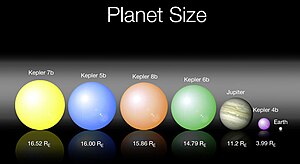| Observation data Epoch J2000 Equinox J2000 | |
|---|---|
| Constellation | Lyra |
| Right ascension | 18h 45m 09.1490s[1] |
| Declination | +42° 27′ 03.891″[1] |
| Apparent magnitude (V) | 13.9 |
| Characteristics | |
| Spectral type | F5V |
| Astrometry | |
| Proper motion (μ) | RA: 2.176(12) mas/yr[1] Dec.: 3.851(14) mas/yr[1] |
| Parallax (π) | 0.9842 ± 0.0105 mas[1] |
| Distance | 3,310 ± 40 ly (1,020 ± 10 pc) |
| Details | |
| Mass | 1.213 M☉ |
| Radius | 1.486 R☉ |
| Temperature | 6213 K |
| Age | 3.84 Gyr |
| Other designations | |
| Database references | |
| SIMBAD | data |
| KIC | data |
Kepler-8 is a star located in the constellation Lyra in the field of view of the Kepler Mission, a NASA-led operation tasked with discovering terrestrial planets. The star, which is slightly hotter, larger, and more massive than the Sun, has one gas giant in its orbit, Kepler-8b. This gas giant is larger than Jupiter, but is less massive, and thus more diffuse. The planet's discovery was announced to the public on January 4, 2010 along with four other planets. As the fifth confirmed planetary system verified by Kepler, it helped demonstrate the capabilities of the Kepler spacecraft.
Nomenclature and history[edit]
Kepler-8 was named the way it was because it is home to the eighth planetary system confirmed during the course of the Kepler Mission, a NASA-directed program tasked with searching a region of the sky for terrestrial planets that transit, or cross in front of (and thereby, for a while, make dimmer) the stars that they orbit with respect to Earth.[3] The planet in orbit around Kepler-8, Kepler-8b, was the fifth of the first five planets discovered by the Kepler spacecraft; the first three planets confirmed by Kepler had been previously discovered, and were only used to verify the accuracy of Kepler's measurements.[4] Kepler-8b's discovery was announced to the public on January 4, 2010 at the 215th meeting of the American Astronomical Society in Washington, D.C., alongside planets in orbit around Kepler-4, Kepler-5, Kepler-6, and Kepler-7.[5]
The data that was used to identify Kepler-8b's existence was re-examined and verified by observatories in Hawaii, Arizona, Texas, California, and the Canary Islands.[6]
Characteristics[edit]
Kepler-8 is situated some 1020 pc (or 3,300 light years) from Earth.[1] With a mass of 1.213 Msun and a radius of 1.486 Rsun, Kepler-8 is more massive than the Sun by about a fifth of the Sun's mass, and is nearly three halves its size. The star is predicted to be 3.84 (± 1.5) billion years old, compared to the Sun's age at 4.6 billion years.[7] Kepler-8 has a metallicity of [Fe/H] = -0.055 (± 0.03), making it 12% less metal-rich than the metal-rich Sun; metallicity is important in stars because stars richer in metal are more likely to harbor planets.[8] The star also has an effective temperature of 6213 (± 150) K, meaning that it is hotter than the Sun, which has an effective temperature of 5778 K.[9][10]

Kepler-8 has an apparent magnitude of 13.9; in other words, as seen from Earth, Kepler-8 is an extremely dim star. It cannot be seen with the naked eye.[10]
Planetary system[edit]
Kepler-8b is the only planet that has been discovered orbiting of Kepler-8.[11] With a mass of .603 MJ and a radius of 1.419 RJ, the planet is 60% the mass of, but 42% larger than planet Jupiter. The planet is diffuse, with a density of .261 grams/cc, especially in comparison to Jupiter and its density of 5.515 grams/cc. At a distance of .0483 AU, Kepler-8b orbits its star every 3.5225 days. The eccentricity of Kepler-8 is assumed to be 0, which would give the planet a circular orbit.[4] In comparison, planet Mercury orbits the Sun at .3871 AU every 87.97 days. Mercury also has an elliptical orbit, with an eccentricity of .2056.[12]
| Companion (in order from star) |
Mass | Semimajor axis (AU) |
Orbital period (days) |
Eccentricity | Inclination | Radius |
|---|---|---|---|---|---|---|
| b | 0.603 MJ | 0.0483 | 3.5225 | 0 | — | 1.419 RJ |
See also[edit]
References[edit]
- ^ a b c d e Vallenari, A.; et al. (Gaia collaboration) (2023). "Gaia Data Release 3. Summary of the content and survey properties". Astronomy and Astrophysics. 674: A1. arXiv:2208.00211. Bibcode:2023A&A...674A...1G. doi:10.1051/0004-6361/202243940. S2CID 244398875. Gaia DR3 record for this source at VizieR.
- ^ "Kepler-8". SIMBAD. Centre de données astronomiques de Strasbourg. Retrieved 2019-11-29.
- ^ "Mission overview". Kepler and K2. NASA. 13 April 2015. Retrieved 7 August 2020.
- ^ a b c "Summary Table of Kepler Discoveries". NASA. 2010-08-27. Archived from the original on 2010-05-27. Retrieved 2010-10-16.
- ^ Rich Talcott (5 January 2010). "215th AAS meeting update: Kepler discoveries the talk of the town". Astronomy.com. Astronomy magazine. Retrieved 27 February 2011.
- ^ "NASA's Kepler Space Telescope Discovers its First Five Exoplanets". NASA. 4 January 2010. Retrieved 27 February 2011.
- ^ Fraser Cain (16 September 2008). "How Old is the Sun?". Universe Today. Retrieved 27 February 2011.
- ^ Henry Bortman (12 October 2004). "Extrasolar Planets: A Matter of Metallicity". Space Daily. Retrieved 27 February 2011.
- ^ David Williams (1 September 2004). "Sun Fact Sheet". Goddard Space Flight Center. NASA. Retrieved 27 February 2011.
- ^ a b "Notes for star Kepler-8". Extrasolar Planets Encyclopaedia. 2010. Archived from the original on 21 January 2011. Retrieved 27 February 2011.
- ^ Jenkins, Jon M.; et al. (2010). "Discovery and Rossiter-Mclaughlin Effect of Exoplanet Kepler-8b". The Astrophysical Journal. 724 (2): 1108–1119. arXiv:1001.0416. Bibcode:2010ApJ...724.1108J. doi:10.1088/0004-637X/724/2/1108.
- ^ David Williams (17 November 2010). "Mercury Fact Sheet". Goddard Space Flight Center. NASA. Retrieved 27 February 2011.